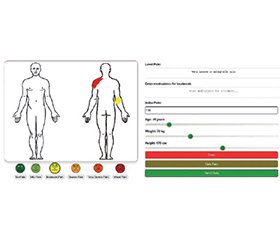Журнал «Медицина неотложных состояний» Том 21, №4, 2025
Вернуться к номеру
Інструмент швидкої оцінки болю з використанням аватара для самозвіту про біль: новий об’єктивний метод адекватної діагностики болю? Пілотне дослідження
Авторы: A. Popelnukha (1, 2), D.V. Dmytriiev (1–3)
(1) - Vinnytsia National Pirogov Memorial Medical University, Vinnytsia, Ukraine
(2) - Pain Management and Rehabilitation Center “Prometei”, Vinnytsia, Ukraine
(3) - Podilsky Regional Oncology Center, Vinnytsia, Ukraine
Рубрики: Медицина неотложных состояний
Разделы: Клинические исследования
Версия для печати
Актуальність. Оцінка болю залишається серйозною проблемою в клінічній практиці, оскільки традиційні шкали самооцінки часто не забезпечують повного розуміння болю, який відчуває пацієнт. Удосконалення штучного інтелекту (АІ) сприяло появі нових методів об’єктивної діагностики болю. Мета: вивчити використання інструменту швидкої оцінки болю (R-PAT), що включає систему самозвіту на основі аватарів, яка дозволяє пацієнтам візуально представляти рівень болю, у такий спосіб підвищуючи комунікацію й точність оцінки. Матеріали та методи. Дослідження проводилося за участі 25 осіб, які страждають від різних видів болю. Учасники використовували програмне забезпечення R-PAT, що включає кольорову шкалу інтенсивності болю від зеленого (немає болю) до червоного (максимальний біль). Модель RGB була використана для математичного розрахунку рівнів болю, яка дозволяє провести кількісну оцінку. Дані були зібрані згідно з етичними принципами за інформованою згодою всіх учасників. Результати. Впровадження системи самооцінки аватарів R-PAT показало значні поліпшення в лікуванні болю. Основні висновки включають: зменшення на 30 % дози анальгетика, необхідної для полегшення болю; 85 % учасників висловили високе задоволення оцінкою на основі аватарів; 72 % пацієнтів продемонстрували клінічні поліпшення з кращими контролем болю та функціональністю. Висновки. У дослідженні підкреслюється потенціал інструменту на основі аватарів R-PAT як інноваційного підходу до оцінки болю. Забезпечуючи більшу об’єктивність та інтерактивність, він підвищує залучення пацієнтів, поліпшує клінічне прийняття рішень і зменшує залежність від ліків. Ця нова технологія може революціонізувати діагностику й лікування болю завдяки більш комплексному та персоналізованому підходу до догляду за пацієнтами.
Background. Pain assessment remains a major challenge in clinical practice, as traditional self-report scales often fail to provide a comprehensive understanding of a patient’s pain experience. Advancements in artificial intelligence (АІ) have introduced new methods for objective pain diagnosis. This study explores the use of the Rapid Pain Assessment Tool (R-PAT) featuring an avatar-based self-reporting system, which enables patients to visually represent their pain levels, thereby enhancing communication and assessment accuracy. Materials and methods. The study was conducted with 25 patients suffering from various types of pain. Participants used the R-PAT software, which employs a color-based pain intensity scale ranging from green (no pain) to red (maximum pain). The RGB model was used to mathematically calculate pain levels, allowing for a quantitative assessment. Data was collected under ethical guidelines, with informed consent from all participants. Results. The implementation of the R-PAT avatar self-report system showed significant improvements in pain management. Key findings include: а 30 % reduction in analgesic dosage required for pain relief; 85 % of participants expressed high satisfaction with the avatar-based assessment; 72 % of patients demonstrated clinical improvements with better pain control and functionality. Conclusions. The study highlights the potential of the R-PAT avatar-based tool as an innovative approach to pain assessment. By providing a more objective and interactive method, it enhances patient engagement, improves clinical decision-making, and reduces medication dependency. This novel technology could revolutionize pain diagnosis and management, offering a more comprehensive and personalized approach to patient care.
оцінка болю; інструмент швидкої оцінки болю; самозвіт про біль; оцінка болю AI; інструмент на основі аватара; діагностика болю
pain assessment; Rapid Pain Assessment Tool; self-pain report; AI pain assessment; avatar tool; pain diagnosis
Для ознакомления с полным содержанием статьи необходимо оформить подписку на журнал.
- Dmytriiev D. Assessment and treatment of postoperative pain in children. Anaesth Pain Intensive Care. 2018;22(3):392-400.
- Bergauer L, Braun J, Roche TR, et al. Avatar-based patient monitoring improves information transfer, diagnostic confidence and reduces perceived workload in intensive care units: computer-based, multicentre comparison study. Sci Rep. 2023;13(1):5908. doi: 10.1038/s41598-023-33027-z.
- Tscholl DW, Weiss M, Handschin L, et al. Using an anima–ted patient avatar to improve perception of vital sign information by anaesthesia professionals. Br J Anaesth. 2018;121(3):662-671. doi: 10.1016/j.bja.2018.04.024.
- Dmytriiev D. Multiple organ dysfunction syndrome: what do we know about pain management? A narrative review. Anaesth Pain Intensive Care. 2019;23(1):84-91.
- Tscholl DW, Weiss M, Handschin L, et al. User perceptions of avatar-based patient monitoring: a mixed qualitative and quantitative study. BMC Anesthesiol. 2018;18:188. doi: 10.1186/s12871-018-0650-1.
- Garot O, Rssler J, Pfarr J, et al. Avatar-based versus conventional vital sign display in a central monitor for monitoring multiple patients: a multicenter computer-based laboratory study. BMC Med Inform Decis Mak. 2020;20:26. doi: 10.1186/s12911-020-1032-4.
- Roche TR, Ganter MT, Tscholl DW, et al. Avatar-based patient monitoring in critical anaesthesia events: a randomised high-fidelity simulation study. Br J Anaesth. 2021;126(5):1046-1054. doi: 10.1016/j.bja.2021.01.015.
- Dobrovanov O, Dmytriiev D, Prochotsky A, Vidiscak M, Furkova K. Pain in COVID-19: Quis est culpa? Electron J Gen Med. 2023;20(1):em435. doi: 10.29333/ejgm/12672.
- Marcilly R, Peute L, Beuscart-Zephir MC. From usability engineering to evidence-based usability in health IT. Stud Health Technol Inform. 2016;222:126-138.
- Wung SF. Human Factors and Technology in the ICU. Crit Care Nurs Clin North Am. 2018;30(2):157-167. doi: 10.1016/j.cnc.2018.03.001.
- Waller RG, Wright MC, Segall N, et al. Novel displays of patient information in critical care settings: a systematic review. J Am Med Inform Assoc. 2019;26(5):479-489. doi: 10.1093/jamia/ocy193.
- Schulz CM, Burden A, Posner KL, et al. Frequency and type of situational awareness errors contributing to death and brain damage: a closed claims analysis. Anesthesiology. 2017;127(2):326-337. doi: 10.1097/ALN.0000000000001661.

